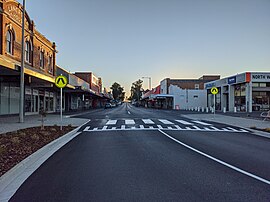|
Ulverstone, Tasmania
Ulverstone is a town on the northern coast of Tasmania, Australia on the mouth of the River Leven, on Bass Strait. It is on the Bass Highway, 21 kilometres (13 mi) west of Devonport and 12 kilometres (7 mi) east of Penguin. As of June 2021 Ulverstone had an urban population of 11,613,[1][2] being the largest town in Tasmania. The town is a part of the municipality of the Central Coast Council, which also includes Penguin, Turners Beach, Leith, Gawler and surrounds, and Forth. History  The town area was first settled by Europeans in 1848, when Andrew Risby, his wife Louisa and their five young children arrived to settle and develop farmland from what was mostly a thickly forested wilderness. Andrew and Louisa arrived in Adelaide, South Australia in 1839 as a newly married couple from their ancestral town of Horsley, Gloucestershire in England. The first of their five children were born in Adelaide. Soon after the birth of their second child they moved to Tasmania. In 1841 they arrived at the Forth River where a young 19-year-old James Fenton had pioneered just prior to their arrival. After clearing land and subsistence farming for a few years, they were evicted from their "patch" after a land dispute with a wealthy speculator and moved westward. The district was, at that time, known as "the Leven" and recognised as a good source of quality timber with a similar climate to England. When their fifth child, Andrew Risby jnr. was two years old the Risby family moved and settled on a patch of land known as The Rises, at the south-eastern perimeter of the present day Ulverstone town boundary where they farmed for many years. Descendants of this pioneering family still live in the district. During the 1850s, the district received a few new settlers but was also frequented by transient timber getters. The timber found ready markets in Melbourne, which desperately required good quality split timber during the Victorian gold rush. Until June 1854, land releases in the district were often purchased under "pre-emptive rights legislation" by distant purchasers whose intention was to keep the land for later sale at an increased price. With the repeal of that legislation, the conditions for settlers to take up residence improved. The name Ulverstone is first known to have been used in 1854 when Hugh Ross McKay opened the Ulverstone store. Leven Post Office opened on 30 May 1857 and was renamed Ulverstone Post Office in 1881.[4] Ulverstone was declared a town on 22 February 1861 by Governor H.E. Fox-Young. Reliable rainfall and generally good quality soils favoured the development of agricultural pursuits. The early pioneers of the district struggled against great odds to secure their sustenance and ultimately develop an income from sale of their produce. Ulverstone grew quite quickly during the 1890s, and the town has become a centralised location between the north-west coast's two cities, Burnie and Devonport. It is named after Ulverston in England, which also sits at the estuary of a river called Leven.[5] Ulverston in England was spelled Ulverstone until late in the 19th century. From 1915 until 1955, a branch railway ran from Ulverstone to Nietta, mostly carrying timber for the Burnie Pulp Mill.[6] In the 1990s, Ulverstone hosted many rallies opposing the decriminalisation of homosexuality, with it being given the moniker of "Australia's most homophobic town" at the time.[7] Male homosexual acts were legalised in Tasmania in 1997, making it the last state to have done so. Redevelopment The Central Coast Council has recently redeveloped the area to increase tourism. 2010 saw the completion of a new basketball stadium, the Schweppes Arena. The arena holds around 1,100 people, cost $5.5 million to build and was completed just behind schedule. it overlooks the River Leven and is situated just behind the former stadium. In 2011, the Leven Bridge was replaced by a new bridge. It was built by VEC Civil Engineering for approximately $6.5 million, with the Department of Infrastructure, Energy and Resources and the Central Coast Council funding the project. In June 2011 a walking track between Turners Beach and Ulverstone was opened. A redevelopment of the wharf precinct was opened to the public on 17 November 2012. ClimateUlverstone has a oceanic climate (Köppen: Cfb), with very mild, relatively dry summers and cool, rainy winters. Influence from the Bass Strait significantly cools the climate, whilst creating noticeable seasonal lag. Average maxima vary from 21.1 °C (70.0 °F) in February to 11.5 °C (52.7 °F) in July while average minima fluctuate between 11.6 °C (52.9 °F) in February and 3.6 °C (38.5 °F) in July.[8] Mean average annual precipitation is moderate, 936.5 mm (36.87 in) spread between 147.3 precipitation days, and is concentrated in winter. Extreme temperatures have ranged from −3.2 °C (26.2 °F) on 17 July 1982 to 30.8 °C (87.4 °F) on 7 February 1967. Climate data was sourced from Forthside, a rural locality 9.3 kilometres (5.8 mi) east south-east of Ulverstone.
EducationUlverstone has three public primary schools and one public high school/college:
There are two private schools in Ulverstone:
As of 2017, students studying Years 11 and 12 can study at Ulverstone Secondary College, or commute to Penguin District School in Penguin, to Don College in Devonport, or to Hellyer College in Burnie. Ulverstone is home to TastroFest - Tasmania's Astronomy Festival. This event is held annually in August and is the largest astronomy festival in Australia. Centred around education, this event holds both student and public programs over three days.[13] Notable people
See alsoReferencesWikimedia Commons has media related to Ulverstone, Tasmania. Wikivoyage has a travel guide for Ulverstone.
|
||||||||||||||||||||||||||||||||||||||||||||||||||||||||||||||||||||||||||||||||||||||||||||||||||||||||||||||||||||||||||||||||||||||||||||||||||||||||||||||||||||||||||||||||||||||||

